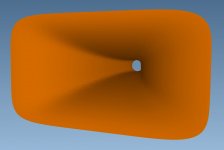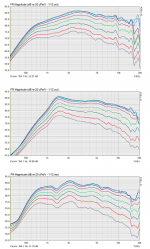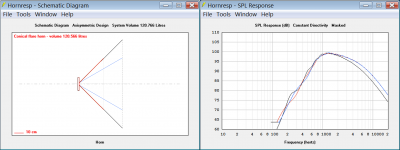The concept consists - at least in my eyes - of a (low) mid-bass wavefront that 'shadows' the A-290.
Those combined woofer cabs form an almost infinite baffle. Basically a wall of low freq. sound from which the mid-highs emerge.
Somehow I'd be tempted to experiment with a first-order crossover, but that would require a large format compression driver.
This is quite correct description.
This kind of tall radiator matrix behaves also like linearray when f is adequately low for the center-center distances. It has vertical directivity of a line array in the low mids and bass.
Regarding 2-way vs. 2,5-way, the 2-way has the best bass coherency and kick and bigger and bolder sound. Sound source feels very large esp. with fast mid transients. As 2-way the mids reminds me slighly of a door sized, curved and segmented ESL, whereas 2,5-way the sound source is more like point source/wavelenght dependent point source ie smaller and shrinks as the wavelenght gets smaller. 2-way is more of a planar wave radiator low mids/bass + spherical (or so) wavefront point source highs.
Last edited:
More or less.
This is quite correct description.
Thanks.
Attachments
There are a few definitions of "cutoff". I suspect most people use (a).
a) In filter designs, the -3dB (N=1) where attenuation begins. [DonVK - this is what I use for nearly everything (drivers, horns, filters, etc) : Cutoff frequency - Wikipedia
b) traditional horn design where throat impedance Im=Re which is also often happens around Re~0.5 so it can be considered like a cutoff where attenuation has started
c) mathematical prediction of "zero" output for an infinitely long exponential flare horn. Since this does not apply to finite horns, it has little practical use.
a) In filter designs, the -3dB (N=1) where attenuation begins. [DonVK - this is what I use for nearly everything (drivers, horns, filters, etc) : Cutoff frequency - Wikipedia
b) traditional horn design where throat impedance Im=Re which is also often happens around Re~0.5 so it can be considered like a cutoff where attenuation has started
c) mathematical prediction of "zero" output for an infinitely long exponential flare horn. Since this does not apply to finite horns, it has little practical use.
Attenuation of what? SPL? That would make no sense, that's why I'm asking because I can't think of any other measurable quantity that would "start to attenuate". Never mind.
Then why does the same driver show different SPL curves (and attenuation) on different horns ?
Because the horns are different 🙄
It simply makes no sense to use the "SPL knee" as an attribute of a horn (i.e. to call it a horn cutoff), because in general it will be different with different drivers. Of course, nothing prevents you from using something that makes no sense, that's up to you. It's only good to make it clear.
It simply makes no sense to use the "SPL knee" as an attribute of a horn (i.e. to call it a horn cutoff), because in general it will be different with different drivers. Of course, nothing prevents you from using something that makes no sense, that's up to you. It's only good to make it clear.
Obviously definitions A or B are relevant, all that needs clarifying is whats just been said, regarding the differences.
A is more of a system cutoff, horn+driver system
B is more technically pointing directly at the horn
Even then, without specifying where the source of cutoff is coming from, questions are left on the table...for example, the cut off of a waveguide....where the source is likely where directivity has fallen off? Something like that...
A is more of a system cutoff, horn+driver system
B is more technically pointing directly at the horn
Even then, without specifying where the source of cutoff is coming from, questions are left on the table...for example, the cut off of a waveguide....where the source is likely where directivity has fallen off? Something like that...
Last edited:
These are three different 1" drivers on the same waveguide. So what is the cutoff of the waveguide?

Attachments
Last edited:
LF Slopes are different, but from the average peak I would say the horns are all starting to attentuate ~1KHz+/-100Hz and then more even attenuation lower down from the driver(s).
From the glossary of "High Quality Horn Loudspeakers" -
Cutoff frequency. The frequency where sound propagation goes from being evanescent to propagating. This can happen in certain types of horns, like the exponential horn, and higher order modes will also have cutoff frequencies. Sometimes also used for the corner frequency of a filter.
Evanescent waves. When a wave is evanescent, its amplitude will decay exponentially. This typically happens below the cutoff frequency.
~~~
I'm not trying to show any expertise because I'm just a freshman student here. But, there is a problem when the teachers can't agree on the definition of terms, or how to use them.
IMO -
Schools of thought may differ but the terms should remain the same. This is engineering.
From my newb perspective, some of the arguments start to look like psycho-acoustic babble, or worse yet, marketing-speak. No offense intended. It's just hard to wade through the mud.
Cutoff frequency. The frequency where sound propagation goes from being evanescent to propagating. This can happen in certain types of horns, like the exponential horn, and higher order modes will also have cutoff frequencies. Sometimes also used for the corner frequency of a filter.
Evanescent waves. When a wave is evanescent, its amplitude will decay exponentially. This typically happens below the cutoff frequency.
~~~
I'm not trying to show any expertise because I'm just a freshman student here. But, there is a problem when the teachers can't agree on the definition of terms, or how to use them.
IMO -
Schools of thought may differ but the terms should remain the same. This is engineering.
From my newb perspective, some of the arguments start to look like psycho-acoustic babble, or worse yet, marketing-speak. No offense intended. It's just hard to wade through the mud.
Last edited:
- Home
- Loudspeakers
- Multi-Way
- Is it possible to cover the whole spectrum, high SPL, low distortion with a 2-way?



